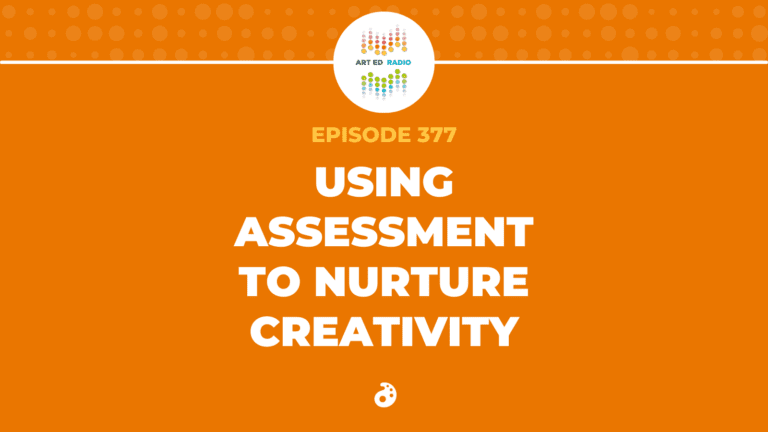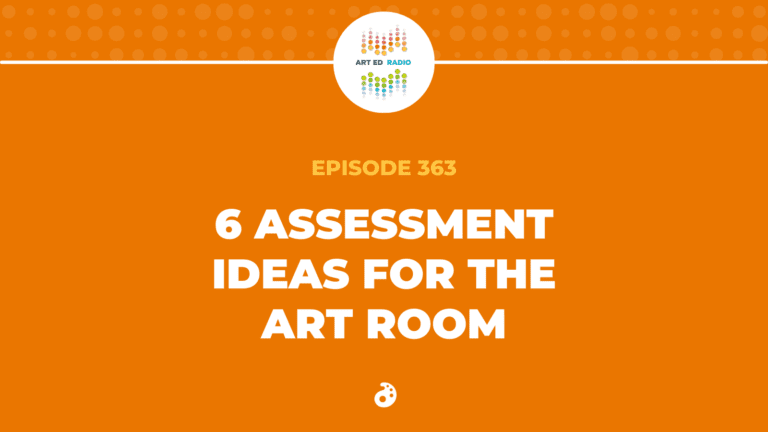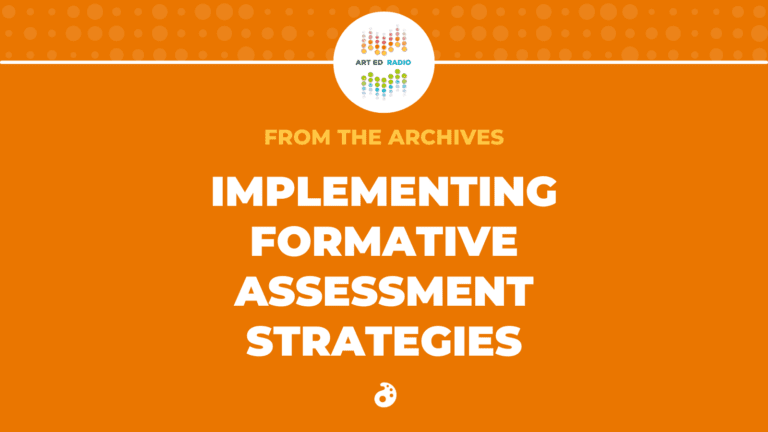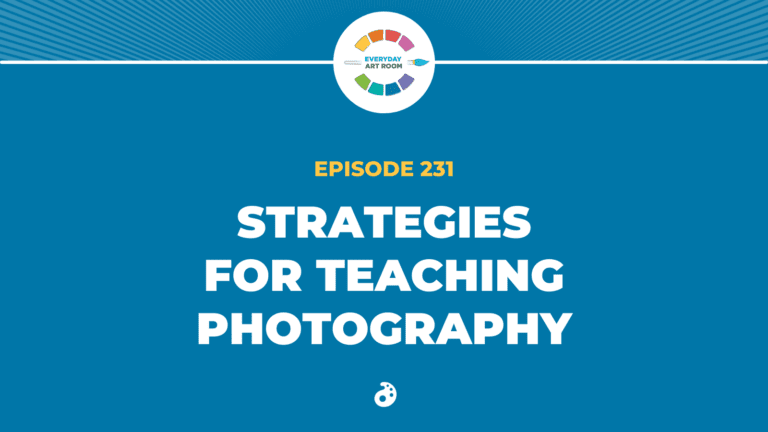The search for the perfect critique is neverending. And, if we’re being honest, the search for even a halfway decent critique can seem neverending as well. Today, Tim talks to Clara Lieu, who is a RISD professor, Artprof.org founder, and critique expert. Their discussion is filled with strategies to improve your critiques, including the ideal size for a quality critique (11:00), strategies to deal with reluctant students (14:00), and how to make your critiques an empowering experience. (18:30). Full episode transcript below.
Resources and Links
- The Art Prof Website
- Art Prof’s Supply Encyclopedia
- Clara’s Ask the Art Professor Columns from Huff Post
- .All of AOE’s Critique & Reflections Articles
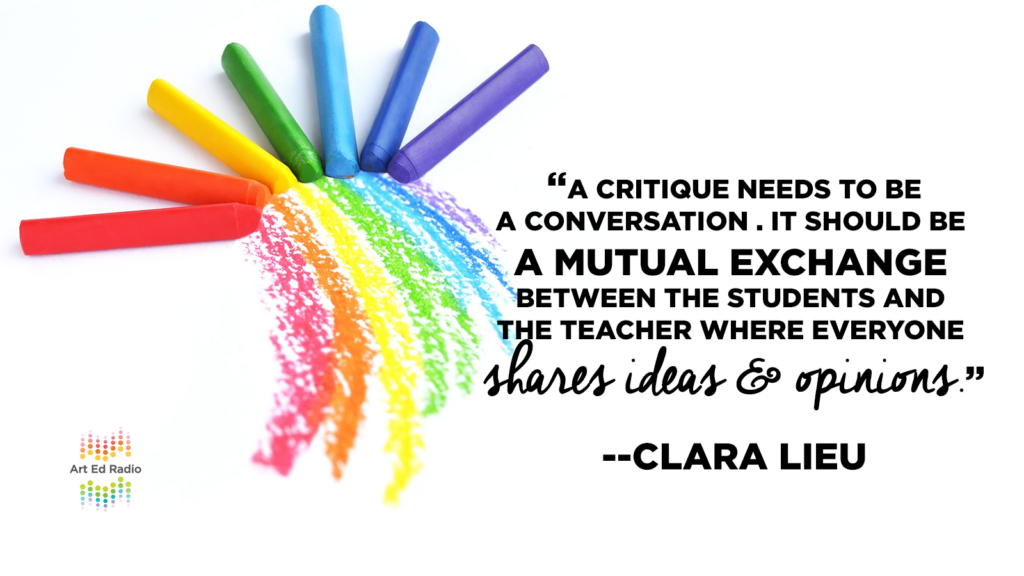
Transcript
Welcome to Art Ed Radio, the podcast for art teachers. This show is produced by The Art of Education, and I’m your host, Tim Bogatz. Conducting critiques is an important part of teaching art. Critiques do so much for our kids. They teach higher order thinking skills, they get students interacting with each other, and maybe most importantly, they help kids get authentic feedback from their peers and their teachers as well. But if you’re gonna do multiple critiques throughout the year, you’re gonna have to move beyond simply holding a discussion with a nervous room full of kids that don’t want to be called on, and probably don’t want to talk.
So today, I want to discuss a few strategies that can get kids interested, get them comfortable, and actually get them talking. Today’s guest is one that I’m pretty excited about. I will be talking to Clara Lieu, who is an associate professor at the Rhode Island School of Design, and a founder of the Art Prof website. Now, if you’re not familiar with Art Prof, it’s juts ArtProf.org, and they feature videos of critiques with different types of art styles, different subject matters, different media, and so much more. It’s becoming just this great page for resources. So make sure you check that out, when you get a chance. And I’ll let her tell you a little bit more about the site in just a second here, but we’re also gonna talk a lot about critiques in general, because, as art teachers, I think we have this weird aversion to critiques, and it may go back to sitting in front of 20, 30 kids that just don’t want to talk, and that leaves kind of a bad taste in our mouth.
And I also think that that aversion kind of starts when you’re first teaching. You have this idea that you don’t want to take studio time away from your kids, and you’re not sold on the benefits of critiquing and reflection and assessment. But even when you evolve a little bit, when you get to that point where you see the importance and the value of critiques, it can still be tough to get kids involved, to keep them involved, to make it interesting, and to make it worthwhile. So in this podcast, I’m hoping to dive into some strategies that can address all of those problems, so let me bring on Clara now, and we can get the conversation going.
All right, I am here now with Clara Lieu. Clara, how are you?
Clara: Doing well. Productive as always.
Tim: Awesome. Glad to hear it. So I’m really excited that you’re joining me today, and before we dive into talking about critiques, I really want to ask you about the Art Prof website. I’m a huge fan. I love everything that you’re doing on there, but for people who maybe aren’t as familiar, can you give a quick overview of exactly what it is you have on the site, what you have to offer for art teachers, and maybe talk about your inspiration for creating it and kind of what you hope to accomplish with the site?
Clara: Mm-hmm. Well ArtProf.org was conceived as being a comprehensive studio art experience that is online. We have video courses, we have video critiques, resources for professional development, information for emerging artists. So the idea behind it was to create a one-stop resource that people could go to so that they didn’t have to visit 18 websites to get all the information they needed. I mean we have everything from conceptual content about how to brainstorm for ideas, which tends to be a little bit abstract and challenging to talk about, but we also have the nitty gritty sort of unromantic side of being an artist, like we have a section called the Arts Applied Encyclopedia, where we give people information about specific tools so they can discover different ways to use them, and I guess the inspiration for ArtProf.org, it really came from when I was blogging for the Huffington Post in 2013, and I was writing these columns that I called Ask the Art Professor, and when I started that column, I thought that I’d write 10 columns, and that would be it.
But actually, I got so many questions from so many people about everything. About color theory, about art school, about how do I hang my work in a gallery, it was everything. And so I was really surprised by not only the diversity of the questions, but also the incredible range of demographics. I mean I had kids who were 12 years old asking me questions. I had people who were working professionals who wanted to do art on the side. I heard a lot from lifelong learners who really had a lot of time on their hands and wanted to dig into something new, so that was really exciting to see that, and I realized that the written column was only gonna go so far because you can only write so much about how to make art. Eventually, people really have to just see it happen, and that’s when I realized, oh my goodness, I really need to transition to a completely different format and also media, which eventually became video.
Tim: Yeah, that’s really cool. And I love all the videos that are there, and I think my favorite on there are when you and your T.A’s are critiquing work. I love all of that. And so I really wanted to kinda jump into talking about critiques, because I know that’s something that a lot of art teachers struggle with. So if I can kind of shift gears to that, I want to ask you, if you were to have an ideal critique, what would that look like in your class. Is it more of a lecture from your end? Is it discussion with your students, among your students, or something in between all of those?
Clara: For me, an ideal critique really would become a conversation. A mutual exchange between students and the teacher, because I don’t think critique is a format where I should just talk and tell the students things and they listen. It’s really important to me that the students are lively participants in the conversation, because it really is them bringing something to the table, me bringing something, and then we exchange different types of ideas and opinions, and I would want it to be a discussion that is not heavily biased toward a specific point of view. I’d want to hear many different points of view. I’d want people to disagree with each other, to bring different types of ideas to the discussion. So I think about it as being highly interactive, and really a place where people are just bouncing off each other left and right.
Tim: Yeah, I really like that. And I think that’s a good goal, because that interactivity is what, at high school level at least, kind of keeps kids from being bored. It keeps them engaged. And like you said, having the diverse viewpoints is something that’s really important. But let me ask you this. What is your attitude, when it comes to dealing with your students, and dealing with critiques? When you’re running your critique, do you have more of a positive approach, where you’re trying to build up students’ confidence? Are you a little harder on them so the focus is more on what they need to improve, or does it just kind of depend on each individual student, or even the individual works that they’re making?
Clara: I think it really is case by case, but I do think the level of the class that I teach somewhat does determine how hard I am on them. For example, when I taught freshman drawing at RISD, we’re pretty tough on them, that first year, because they come into art school, it’s the first time in college, and so you really have to whip people into shape for lack of a better word. If you don’t have any experience at all in that situation, you really have to just get people going right away, whereas whenever I’ve taught a class for upperclassmen, like, for example, right now I’m teaching a sophomore drawing class in the illustration department at RISD, you know that people have been through countless numbers of critiques, they’re very experienced, and so the expectations, I think, are a little bit different in that sense, but fundamentally speaking, every single critique, and every single student, completely different.
So it really depends on the students, because I sometimes have students who really don’t need their egos massaged anymore, and who don’t need that version of a critique, who really just need to be hit with a lot of constructive criticism, and I do have students who I recognize, okay, they’re struggling a little bit, but wow, let’s really recognize how hard they’re working to get to where they are. A couple years ago, I had a student who brought in this collage, and it was a total train wreck. I mean she said at the critique, she said, “I’m so embarrassed to bring this in. It looks terrible.” And you could see she struggled with it, because there was glue all over it. It was very messy, and all the pieces were cut awkwardly.
So she came in anticipating that I was just gonna dump all over her and tell her she’d done such a terrible job, and I admitted that, yes, it looked like a train wreck, however I commended her for sticking with the project and really following through, because I think a lot of students, when they can see that their project isn’t going well, the tendency is to just say, “Oh, I’m gonna give up, because there’s no point.” I said, “Look, you knew it was a train wreck, but you finished the race. That’s fantastic. And the fact that you didn’t surrender to the challenges of the project was really great.” And so she really needed to hear that, because she knew it was a big mess. She didn’t need me to tell her it was a big mess. It was very obvious. And so I thought to myself, well, how can this become a really constructive experience? And that was a good lesson, not just for her, but for the other students to recognize that, wow, effort goes a really long way, and even though the product wasn’t the best thing ever, they really learned from that experience.
Tim: Yeah, that’s really good. And just as teachers, we talk all the time about getting kids into a growth mindset and really appreciating their effort and their hard work, so I think that’s an awesome example of how that can really take place in a critique, so yeah, that’s awesome. Another thing that I wanted to ask you about, one thing that I always struggled with in the classroom, and one thing that I know a lot of teachers struggle with is they have these huge classes, and so I guess I wanted to ask you, in your mind, how many people make for a good critique? Because for so many of us, it’s difficult to run critiques if you have 30 kids in your class, so if you are overwhelmed with big classes, what would you tell teachers? How can you do successful critiques when you have so many kids in your classroom?
Clara: Right. It can be tricky, because some critiques really do need a lot of time and attention to be successful, because I never want to just breeze through somebody’s critique, and make them feel like they weren’t given enough attention. So what I’ve done, whenever I’ve had short class time, or very large classes, sometimes I’ll divide the class in half. So let’s say you have 30 students. I’ll say, “Okay, this group of 15 students, we’re gonna have a critique together, and then the other 15 students will be working on another project,” say the next project. And then the next day, we’ll switch, so that way everybody gets really good attention, in that situation, because I’ve found that 15 is ideal. But I mean, come on, how many of us really teach classes with 15 students?
Tim: Exactly.
Clara: That’s not really very common, but the thing is, you don’t want to have so few students that it’s difficult for people. Like I almost think 10 students is not enough, because then, inevitably, you have some people that talk a lot, and you have some people who are very shy about it, and you don’t want to have, for example, two students totally dominating the conversation. So I’ve found, when you have 15, that’s just about right. I think 20 is pushing it a little bit. So I like to have 15 when I can, and then I also sometimes supplement with one-on-one critiques.
For example, I have some multi-week projects where I’ll say, “Okay, well this week is the second of the project. Let’s skip the group critique, and I’m just gonna talk to everybody one-on-one.” And so I like mixing up the different critique formats because when you talk to a student one-on-one, it’s such a different dynamic. I mean, they’ll say things to you that they might be embarrassed to say in front of the group, but I also think a group is terrific, because you have all those different opinions in one place, and it can be a great conversation. I mean I’ve had critiques, honestly, that were so much more entertaining than anything you could watch on Amazon or Netflix, and I’ve been in critiques where we’re just rolling on the floor laughing, and other times where we’re just deeply engaged and really, really focused.
So there are so many different combinations and ways that critiques can be run, and I guess the whole point is to just present different ways of doing it, because I’ve also been in critiques, myself, where I was being reviewed by three professors at the same time, and that’s a totally different dynamic. So I think, ideally, I’d want students to experience all those different formats.
Tim: Yeah. If I can kind of follow up on that, just thinking about different formats, different ways of doing critiques, when you’re teaching high school or middle school, it can be really tough for us to get kids out of their shell and really participating in a critique, and I know, obviously, you’re teaching at the college level, but do you have any strategies that you think can help kind of get reluctant students or shy students kind of engaged in the discussion, just different things that you can do with your critiques to really get everybody participating?
Clara: Yeah, I mean the first thing that I make really clear during class is to say, “Look, guys, I’m not looking for you to use particular words. There’s no vocabulary that you have to have, to speak in a critique,” because students will say to me, “Oh, well I don’t have the right terminology. I don’t know what words to use.” And so I say to them, “Guys, just use the words you have. I don’t care what words you have. Just try.” And really, I say to them, that’s what I’m looking for. I’m not looking for a particular way of speaking. I just want to see you try. That’s the most important thing.
And the other thing I say to them is, “Look, if you guys really engage with your class, it’s up to you guys to make it a good experience. Because if you guys don’t care, and you don’t try, I can tell you, the critiques are gonna be horribly boring, and we’re all gonna just … our butts are gonna hurt during critiques, and it’s just not gonna be fun.” And so I really push on them, the first day of class, that a successful critique is up to the group. It’s not up to me and the T.A. Because sometimes they think it’s my job to make it a good critique, and I am there to facilitate the discussion, and to lead things, but I’m not what makes a good critique. It’s the entire group effort.
So there’s that. And then finally, ultimately, you’ll have some kids who really, no matter how many times you say to them all of these different things, are still very much very hesitant, really shy. I mean, it’s nerve wracking to talk in front of a group of people if you’re not used to it, and so I don’t call on them, because I find that that just creates a lot of stress for them because they already are hesitant for a reason, and so usually I’ll check in with them, maybe midterm or something, and I’ll just say, “Hey, well I’ve been noticing you’re not really talking in critiques very much. Can you tell me why you’re hesitating?”
So usually it’s one of a couple things. Some students will say, “Look, I’m just so shy. I’m so, so nervous about talking,” or some students will say, “Well, I feel like whatever I want to say, somebody else already said it,” in which case I’ll say to them, “Well, look, maybe they said it already, but maybe you have a different way of saying the same thing. Maybe your delivery is different.” And so therefore, it will be impactful in a different way. So I’ve just found that approaching them outside of the critique and just giving them a little bit of attention there, it makes them realize, number one, that I’m noticing, and number two, we can talk through what some of the issues are.
Tim: Yeah, that makes a lot of sense, and I think that’s a really, really good strategy, too. So thank you for that. Then I guess I just had one last question for you, to kinda wrap things up, and that is, what do kids need to walk away with? What should be our goal as teachers? What should be kids’ takeaway as far as what they’re able to get, what they’re able to learn from a good critique in our classroom?
Clara: At the end of a critique, I guess what I’m looking for students to get out of the experience is to feel that they have an understanding of how their work is impacting an audience, because a lot of students, when they work on a project, they have some intent. Let’s say they want to create something which gets a really emotional reaction, and so for them to say, “Oh, wow, my piece did not elicit the emotional reaction I was looking for. I really have to change things,” or to say, “Wow, I really nailed it, and I got the result I was looking for.” So for them to have an understanding of that, and to know the reasons why or why not it had that emotional impact. So to say, “Oh, well I realize it’s because the image was so gray, and it lacked contrast, so it didn’t quite have the emotional punch I was looking for.” And then the other takeaway is for students to leave the critique feeling that they know what to do next. That they know what their next goal is. Whether it’s short-term goals, whether it’s long-term goals, for them to say, “Okay, what’s the next step?”
So if the student leaves a critique just feeling like they don’t know anything about why their piece did or did not impact, or if they leave feeling like, “Well, I just don’t know what to do,” that’s not very empowering. And so I want students to feel, when they leave a critique, “Oh, wow, I’m so excited. I can’t wait to do this next, and I know that I can make these changes.” So in some ways, I think a critique should be an empowering experience. It should be inspiring. It should make you feel like you want to get up and do something, because you were so inspired by something that was said at the critique. So hopefully, for me, at the end, the only thing … well not the only thing. But one of the things they really want to do is just get up and work again.
Tim: Yeah, that’s really well said, and I think that’s an awesome goal for everyone to have, is just yeah, like you said, to inspire kids to get back and get working. So cool, I think that’s a great place for us to wrap it up. Clara, thank you so much for joining me, and for all of the awesome advice.
I am so glad I had the opportunity to talk to Clara. I feel like she has some really effective strategies for bringing more critiques into your classroom and some great ways for you to do them a little bit better. Now just a couple things that I want to tell you about. If you are following up and want to learn a little bit more about critiques, or a little bit more about these strategies, of course, the Art Prof site that we mentioned is gonna be worth your time. If you’re looking for AOE specific resources, make sure you check out Art Ed PRO. There is a great learning pack in there, with Johanna Russell that’s called Finding Success with Critiques at Every Level. It has information on getting kids to participate, on scaffolding your critiques, and a lot of different ways that you can extend learning. It’s got a ton of handouts and resources and downloads that can really help you if you’re looking to learn more about critiques.
You can find that pack, and the other almost 70 learning packs at theartofed.com/pro. And finally, I have an article publishing tomorrow that kind of wraps up all of our conversation here with Clara, and shows you, specifically, how you can incorporate some of these ideas in your classroom. Check out the main site to find that when it publishes tomorrow morning. And that’ll be all for this episode. Thanks for joining me, and another big thank you to Clara for coming on. I’ll leave you with an idea from her that really sums up this episode well. I don’t think I can quote it exactly, but she said it’s really important that students are a lively part of this conversation. When we’re doing critiques, we need to hear as many different points of view as we can. We need to disagree with each other. We need to bring different types of ideas. That’s what critiques need to be about.
Art Ed Radio is produced by The Art of Education, with audio engineering from Michael Crocker. You can sign up for our email list at artedradio.com, and get updates from me every single Tuesday about that week’s episode. They are informative and sometimes hilarious, at least I think they are, and usually worth your time. You are missing out if you’re not signed up, but thank you, as always, for listening, and I will talk to you next week.
Magazine articles and podcasts are opinions of professional education contributors and do not necessarily represent the position of the Art of Education University (AOEU) or its academic offerings. Contributors use terms in the way they are most often talked about in the scope of their educational experiences.
